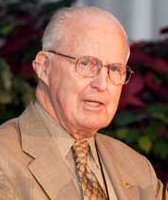The Green Revolution

The Green Revolution, a period of intense technological change in global agriculture during the latter half of the twentieth century, grew from a combination of political agendas, financial support, scientific advances, and changes to farming. A part of the Research, Ethics, and Society project, this case can be used to address the social responsibilities of researchers, particularly those concerning cross-cultural contexts, and understanding knowledge and technological systems as an important tool for acting on social responsibilities.
- How can researchers contribute to reducing hunger in cultures and countries far removed from their laboratories?
(Via Wikimedia Commons)
The Green Revolution, a period of intense technological change in global agriculture during the latter half of the twentieth century, is often associated with the Rockefeller and Ford Institutes, and Norman Borlaug. In 1944, Borlaug, a PhD plant pathologist and geneticist, took a position with the Rockefeller Foundation's Mexican hunger project. His initial research in Mexico, as adopted by governments, international institutions, and local farmers, soon led to worldwide changes in agriculture. It helped India and Pakistan avoid mass starvation and, later, become self-sufficient in wheat and rice production. Borlaug's work highlights how combining science with public policy can address social responsibilities.
How did Norman Borlaug get involved?
Borlaug began his research career as a bench scientist but quickly took what he learned in the laboratory to address his growing concern for people in countries confronting chronic hunger. In research, he worked mainly on approaches for producing high quality and high quantity grains. The first few years of Borlaug's work were a massive undertaking. He was directly involved with:
- Finding locations for and planting experimental wheat fields
- Maintaining and harvesting wheat
- Recruiting farmers
- Training young Mexican scientists and technicians
By 1956, Borlaug and his colleagues had developed forty new pest-resistant, high-yielding wheat varieties that provided a starting point for making Mexico self-sufficient in wheat production.
Turning Individual Concern into Broad Social Responsibility
In the early 1960s, the Rockefeller Foundation, based on success in Mexico, shifted its attention to an international agriculture program. Borlaug's work helped the Rockefeller Foundation inaugurate the International Rice Research Institute (IRRI) and the International Center for Maize and Wheat Improvement (CIMMYT). Borlaug trained young scientists in research and production methods, and he strongly advocated sharing all of CIMMTY's data and materials worldwide, free of charge.
Borlaug proposed a hands-on apprenticeship program for scientists from the Middle East and South Asia. He knew that making his agricultural projects self-sustaining would best serve science and social progress. Borlaug insisted on training local scientists and technicians in order to establish national agricultural research systems in developing countries.
Engaging with the Public
Along with fieldwork, institution building, and educating, Borlaug also acted on his social responsibilities by becoming involved with public policy. As a scientist and practical humanitarian, Borlaug looked beyond Mexico to India and Pakistan. Farmers in this region, and society more broadly, initially resisted the new high-yield crop management practices. Borlaug met with prime ministers, ministers of agriculture, economists, and farmers from India and Pakistan to:
- Open dialogue and to convince officials and farmers to follow his wheat and rice-growing guidelines
- Offer his expertise when others' suggestions were ignored and convince both countries to adopt policies that would encourage farmers to use the new production technologies
Because of Borlaug's insistence on meeting with farmers and working side-by-side with them, he understood the systems—both social and technical—of wheat and rice farming. By the late 1960s Pakistan had ceased its dependency on wheat imports from the U.S. India also produced enough grain to support its population, becoming self-sufficient in wheat and rice and tripling its wheat production between 1961 and 1980.
The Green Revolution has both proponents and critics. Some circles lauded the changes as a successful intertwining of science and public policy that helped save several countries from mass starvation. Proponents pointed out that the changes:
- Raised farmers' incomes
- Slowed increases in rural poverty
- Improved the nutritional value of wheat, maize, and rice
- Decreased starvation rates
- Helped avert worldwide famine in the late twentieth century
Critics responded that the changes:
- Caused environmental harm through substantial use of chemical fertilizers and pesticides
- Made agriculture in the developing world dependent on Western agribusiness products such as hybrid seed and fertilizers
- Disrupted long-standing social systems in rural areas
- Advocated a blanket solution to agricultural problems rather than regional approaches
- Significantly undermined regional foods and genetic biodiversity
Tilman, D. (1998). The greening of the green revolution. Nature, 396 (6708), 211–212.
Recognition
From 1944 through 1979, Borlaug worked as a Rockefeller Foundation field scientist. Even after retiring, Borlaug remained active in agriculture research and acted as a liaison between governments and farm workers. The 1970 Nobel Peace Prize committee recognized Borlaug for his role in helping modernize agriculture in developing countries.
Additional Resources
- Shiva, V. (1991). The violence of the green revolution: Third world agricultures, ecology, and politics. New Jersey: Third World Network.
- Evenson, R. E. & Gollin, D. (2003). Assessing the impact of the green revolution, 1960 to 2000. Science, 300(5620), 758–762.
This case is based upon work supported by the National Science Foundation under Grant No. 1033111. Any opinions, findings, and conclusions or recommendations expressed in this material are those of the author(s) and do not necessarily reflect the views of the National Science Foundation.
Our project team and advisory board read many drafts and provided important insights. Project team: Heather Canary, Joseph Herkert, Jameson Wetmore, Ira Bennett, and Jason Borenstein. Advisory board: Joan Brett, Jim Svara, Richard Fish, Juergen Gadau, Shelli McAlpine, Timothy Newman, Byron Newberry, Patrick Phelan, and Petra Schroeder.


